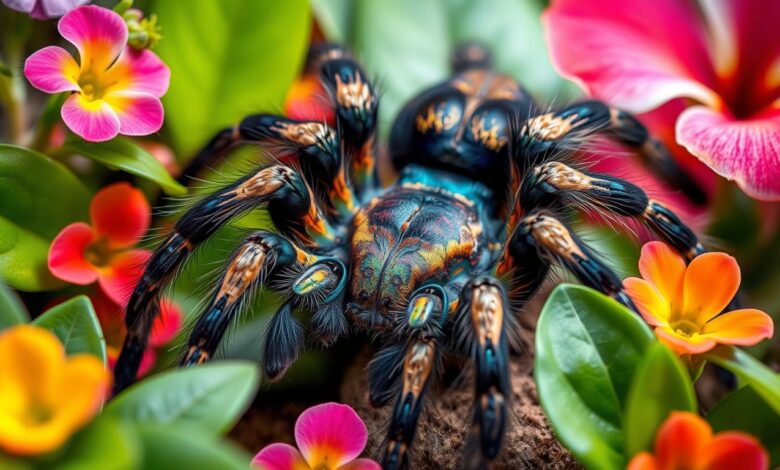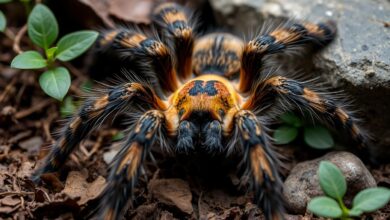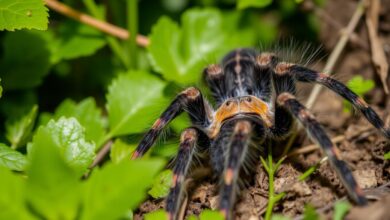Exotic Tarantula Species

Get ready for an exciting journey into the world of exotic tarantulas! These amazing creatures are known for their large size, bright colors, and unique behaviors. You’ll learn about their mysteries and marvels, and why they make great pets.
Meet the Goliath birdeater, the biggest tarantula around, and the arboreal species that live in trees. You’ll be amazed by the variety of exotic tarantulas. They come in many colors and patterns, showing off nature’s art.
This article is for both experts and beginners. It will take you through the different homes of exotic tarantulas, like rainforests and deserts. You’ll learn how to take care of these amazing pets.
Exploring the Captivating World of Exotic Tarantula Species
Tarantulas are fascinating spiders that have many different kinds. They are known for their amazing variety. Each species has its own special traits and beauty. From big ones that live on the ground to small ones that climb trees, they are all interesting.
Tarantulas: Regal Arthropods with Remarkable Diversity
The tarantula family, known as Theraphosidae, has a huge number of species. These amazing spiders live in many places around the world. They are found in everything from rainforests to deserts, each one suited to its environment.
The Allure of Exotic Tarantula Keeping
People love keeping exotic tarantulas as pets because they are so interesting. These spiders have bright colors, detailed patterns, and beautiful movements. Watching them up close is a special experience for those who love them.
Whether it’s the big size of some tarantulas or their ability to climb, these spiders are amazing. Exploring the world of exotic tarantulas can make you appreciate their beauty and diversity more. You’ll learn to respect these incredible spiders as you get to know them better.
Venomous Marvels: A Closer Look at the Most Potent Exotic Tarantulas
Most tarantulas have mild venom, but some are very dangerous. These venomous tarantulas and potent tarantulas use their venom to protect themselves. They are fascinating to those who love spiders and study them.
The [https://tarantulaswild.com/tarantulas-in-asian-jungles/]Poecilotheria genus, or “Ornamental Tree Spiders,” are well-known. They live in the jungles of Asia and are known for their bright colors and quick moves. Their venom can cause a lot of pain, nausea, and even temporary paralysis.
| Venomous Tarantula Species | Venom Potency | Native Habitat |
|---|---|---|
| Poecilotheria Metallica (Metallic Ornamental Tree Spider) | Highly Potent | Sri Lanka |
| Poecilotheria Regalis (Regal Ornamental Tree Spider) | Highly Potent | India |
| Haplopelma Lividum (Cobalt Blue Tarantula) | Potent | Southeast Asia |
These venomous tarantulas remind us to be careful around them. Their venom is strong, but they are also beautiful and important to the environment. They are truly fascinating exotic venomous spiders.
Terrestrial Titans: Massive Exotic Tarantula Species
In the world of exotic tarantulas, some species are truly massive. These “terrestrial titans” amaze everyone with their size. The Goliath birdeater stands out as the biggest tarantula on Earth.
The Goliath Birdeater: A True Giant Among Tarantulas
The Goliath birdeater, known as Theraphosa blondi, is a wonder. It can have a legspan of up to 12 inches. This makes it a legendary tarantula. Its body is up to 6 inches long, making it a giant among others.
This tarantula is known for its powerful presence. It’s the biggest tarantula species and one of the heaviest spiders, with some weighing over 6 ounces.
| Characteristic | Goliath Birdeater |
|---|---|
| Legspan | Up to 12 inches |
| Body Length | Up to 6 inches |
| Weight | Over 6 ounces |
The Goliath birdeater is not just big; it’s also beautiful. These massive tarantulas have a thick, hairy body and bright colors. They range from dark brown to reddish-brown. Their size and look make them a wonder in the exotic large tarantula world.
Arboreal Acrobats: Exotic Tarantula Species That Thrive in Trees
Many tarantulas live on the ground, but some exotic ones live in trees. These “arboreal acrobats” are agile and graceful in the treetops. They don’t fit the usual image of tarantulas as ground-dwellers.
The Graceful Movements of Arboreal Tarantulas
Arboreal tarantulas, or tree-dwelling tarantulas, have special traits for living in trees. Their long legs and light bodies let them move with grace. They easily cross tree branches and trunks while hunting and finding shelter.
Species like the Poecilotheria and Psalmopoeus show off their unique skills. Each arboreal tarantula has its own style and ways to survive. They interest both fans and scientists with their exotic beauty.
Exploring exotic tarantulas shows how amazing the arboreal acrobats are. Their tree lives and beautiful moves give us a new view of tarantulas. They prove how adaptable and graceful these creatures can be.
Exotic Tarantulas: Captivating Colors and Patterns
The world of exotic tarantulas is a visual treat, filled with stunning colors and patterns. These creatures are like living art, showing off nature’s creativity.
Nature’s Artistry: The Vibrant Hues of Exotic Tarantulas
Exotic tarantulas come in a range of colors, from deep jewel tones to mesmerizing patterns. They are truly vibrant, drawing the eye and sparking the imagination. Their colors make them look like nature’s own art pieces.
The Peacock Spider is famous for its bright colors like red, white, blue, and yellow. The Bold Jumping Spider has a striking black and white look that scares off predators. The Regal Jumping Spider is a favorite pet for its bright colors and friendly nature.
Exotic tarantulas show off a wide range of colors, from navy blue to fiery red. Each species has its own special colors and patterns. These tarantulas are amazing, inspiring awe and wonder in everyone who sees them.
The Gray Wall Jumping Spider has a zig-zag pattern, while the Twin-flagged Jumping Spider has a two-colored design. The Heavy Jumping Spider is known for its bright colors and can jump really high when scared.
Exotic tarantulas show how creative nature can be. They have a wide range of colors and patterns that make us wonder and appreciate their beauty.
Tarantula Care: Unlocking the Secrets of Successful Exotic Species Husbandry
Keeping exotic tarantulas requires a deep understanding of their unique needs and environment. Whether you’re a seasoned tarantula enthusiast or new to exotic arachnids, learning tarantula care is key. It ensures these fascinating creatures stay healthy and happy.
Starting with the right exotic tarantula husbandry means creating a good home. Tarantulas like different homes, from underground burrows to tree-like setups. It’s important to know what your exotic tarantula species needs to make their home comfortable and interesting.
- Proper substrate selection: Mimic the natural substrate of your tarantula’s habitat to support their burrowing and nesting behaviors.
- Appropriate temperature and humidity levels: Maintain the ideal conditions to replicate the tarantula’s native climate.
- Adequate hiding spots and climbing structures: Offer a variety of hiding places and vertical elements to cater to their natural instincts.
Feeding your exotic tarantula is key to their health. Tarantulas eat different things, like live insects or rodents, based on their size and type. A balanced diet is vital for their health and happiness.
Understanding the needs of exotic tarantulas is the first step to successful care. With the right care and dedication, you can create a great home for these amazing arachnids. This way, you’ll enjoy the rewarding experience of keeping exotic tarantulas as pets.
Venturing into the Wild: Exotic Tarantula Habitats Around the Globe
Start an amazing journey with us as we look into the homes of exotic tarantulas. They live in everything from lush rainforests to dry deserts. These incredible spiders have learned to live in many different places all over the world.
From Rainforests to Deserts: Diverse Habitats of Exotic Tarantulas
Tarantulas live in many beautiful places, each with its own challenges and chances for them. In the tropical rainforests, some species climb high up in the trees, while others dig in the damp soil. In the dry, desert regions, they’ve learned to survive with little water and high heat.
Then there are the mountainous regions, where tarantulas adapt to the tough terrain and cooler climates. The subtropical zones are another home for them, where they fit right in with the greenery and mild weather. They even live in grasslands and deciduous forests, showing how well they can adapt.
As you explore the wild, you’ll see how tarantulas and their environments work together. Each place has its own set of challenges, which affects the tarantulas’ looks, behavior, and how they survive. Join this exciting trip and discover the secret lives of tarantulas.
Handling Exotic Tarantulas: Embracing the Thrill and Responsibility
Dealing with exotic tarantulas can be thrilling, whether for research, conservation, or as pets. It’s important to handle them with care. Knowing how to handle tarantulas safely is key for both the handler and the tarantula. When you start handling tarantulas, remember to focus on responsible tarantula care and the importance of exotic tarantula handling.
Tarantulas are unique and need careful handling. Before you start, learn about their needs and behaviors. This will help you appreciate and care for them better.
- Understand the species-specific temperament and venom potency of the tarantula you’re handling.
- Utilize appropriate protective gear, such as thick gloves, to safeguard your hands and arms.
- Employ gentle, deliberate movements to avoid startling the tarantula and minimizing the risk of defensive behaviors.
- Provide a secure and comfortable environment for the tarantula during handling sessions.
- Respect the tarantula’s personal space and avoid unnecessary disturbances to its natural behaviors.
The excitement of handling exotic tarantulas comes from seeing their movements, patterns, and adaptations. This close look at nature can be very rewarding. It helps you understand and respect these amazing creatures more.
| Tarantula Species | Venom Potency | Handling Difficulty |
|---|---|---|
| Theraphosa blondi (Goliath Birdeater) | Relatively Low | Moderate to High |
| Poecilotheria metallica (Metallic Parachute Spider) | High | High |
| Aphonopelma chalcodes (Arizona Blonde Tarantula) | Low | Low to Moderate |
| Stromatopelma calceatum (Peacock Tarantula) | High | High |
By handling exotic tarantulas with care and respect, you can learn to appreciate them more. This approach helps with their conservation. Remember, being thoughtful and respectful is key to enjoying the world of exotic tarantulas.
Exotic Tarantula Species as Fascinating Pets
For those who love spiders, keeping exotic tarantulas as pets is exciting and fulfilling. These spiders open a window into the spider world. They spark the imagination and create a strong bond between humans and animals.
The Joys and Challenges of Keeping Exotic Tarantulas as Pets
Having an exotic tarantula as a pet is both rewarding and challenging. The joys include watching their behaviors and seeing their bright colors. It also feels great to care for them well.
But, it’s important to meet their special needs. This means creating the right home and keeping them healthy. People who want to keep tarantulas as pets need to learn a lot. They should look for good advice and resources to help their tarantulas thrive.
If you like the Goliath Birdeater or the graceful arboreal tarantulas, exotic tarantulas can be a great choice. Taking on the challenge of owning one can deepen your respect for these spiders. It can also create a special bond with your pet.





